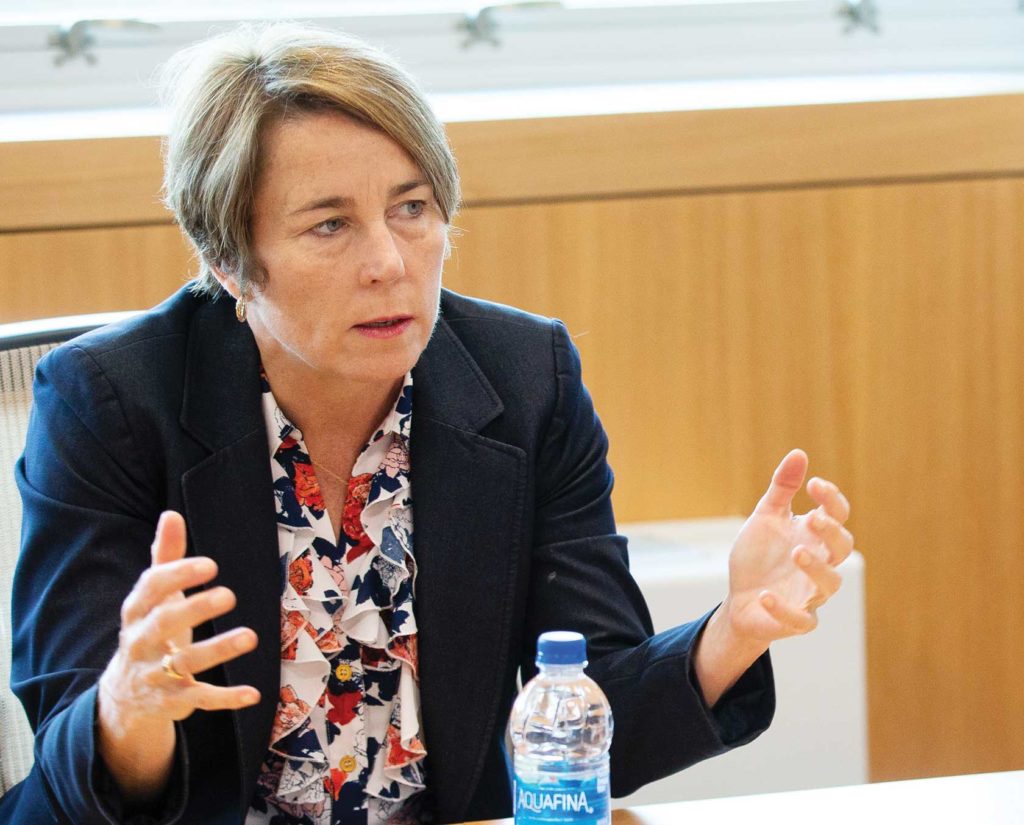Will Healey’s diverse transition team translate into an inclusive administration?

On the campaign trail, Maura Healey ran as a centrist, offering little insight into how she would govern differently than outgoing Republican Governor Charlie Baker.
But as she begins assembling a new administration, activists in the Black and Latino community can think of one area where they’d like to see a change: diversity at the top.
In Baker’s cabinet, Secretary of Labor and Workforce Development Rosalin Acosta, who is Cuban American, stands out as the only Latina. There are no Black or Asian people in the cabinet. Among Baker’s senior advisors, legal counsel and other “kitchen cabinet” positions, former Deputy Chief of Staff Tony Richards until last year stood out as the sole person of color.
Healey’s transition team, whose leadership includes eight people of color and seven whites, signals the promise of a more diverse administration. Among those leading the teams are Mass League of Community Health Centers President and CEO Michael Curry, Latinos for Education Executive Director Amanda Fernandez and Bunker Hill Community College President Pam Eddinger.
But it remains an open question whether the diversity on the transition team will translate into a diverse administration.
“As this administration forms, one of the most important metrics will be the number of Black people she has in her cabinet,” said former City Councilor Tito Jackson, who served under the Deval Patrick administration in the Executive Office of Housing and Economic Development.
Jackson said a diverse cabinet would better equip the Healey administration to tackle issues of inequality in the state.
“You can’t fix the things that you don’t face,” he said. “It is critical that anyone leading the state of Massachusetts have a cabinet that’s reflective of the state.”
In Patrick’s cabinet, people of color occupied key positions, including Health and Human Services and Public Safety. Major agencies headed by people of color included the MBTA and the Division of Capital Asset Management and Maintenance.
Patrick’s office staff included Mo Cowan as chief of staff, Lily Mendez-Morgan as deputy chief of staff and David Morales as a senior advisor.
“It made a huge difference,” said Doug Chavez, who served as deputy director of the state’s Supplier Diversity Office. “People from our communities felt like they had a voice in government. They could come to the governor’s office and not feel like an outsider. People had access.”
Having people of color serving as secretaries and heading major departments often means human resource departments pull from a wider pool of job applicants, notes state Rep. Carlos Gonzalez, a Democrat from Springfield.
“People usually select people they have relationships with, people they go to the same churches with. People with the same upbringing,” he said.
Among constitutional offices, Baker’s did not appear to do well with diversity in hiring. A 2021 analysis of state data by Commonwealth Magazine found that his executive branch workforce was 30.2% people of color, but within the governor’s office, the workforce was just 12.5% people of color.
In Healey’s Attorney General’s Office, the workforce was 21% people of color — higher than that of Baker’s office and the workforce headed by Secretary of State William Galvin, but lower than that of Auditor Suzanne Bump and Treasurer Deborah Goldberg. A spokeswoman for Healey’s office this week said the percentage is now 23%. The spokeswoman noted that that number had nearly doubled from 2015, when the workforce was just 12% people of color.
NAACP Boston Branch President Tanisha Sullivan said that beyond the diversity of the cabinet and heads of major state agencies, she wants to see policies that meet the needs of the state’s diverse communities.
“Most of us want to see leadership in our government that is reflective of our communities,” she said. “That said, diverse representation is not enough. What we need to see is policies and initiatives championed by our elected officials that ensure all residents of Massachusetts are able to benefit from the growth and prosperity of the commonwealth.”
While Baker’s cabinet and inner circle were mostly white, Sullivan and Gonzalez noted that his administration made some progress in tackling inequities in state contracting.
The share of state contracts going to minority-owned businesses rose from 2% in 2020 to 3% in 2021. The Baker administration conducted disparity studies and ordered all state agencies to devise procurement plans aimed at increasing purchasing with minority vendors and to appoint supplier diversity officers to oversee the execution of the plans.
Gonzalez, who along with other members of the Legislative Black and Latino Caucus pressured Baker to expand minority contracting, gave the Baker administration credit for its efforts.
“They reviewed their data and made changes,” he said. “They did a fairly good job with that. The Baker administration was very open to dialogue with the Black and Latino Caucus.”
Gonzalez said he and his colleagues on the Caucus hope to continue their advocacy, working with the Healey administration on pushing for increased homeownership among Black and Latino communities and more business ownership and contracting opportunities.
For those goals, Gonzalez says, the Caucus will need allies in the Healey administration.
“A diverse administration would send a good signal of what they will accomplish,” he said.







